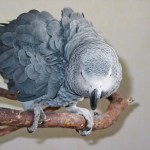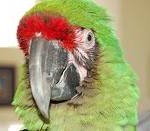Avoiding Bird Bites
I love birds and sometimes I frighten them by being too fast and forward with them. I know lots of people put themselves in a position to be bitten by not knowing a little bit about bird body language and when to back off. In Parrot Forum article, “Reading your Parrot’s Body Language,” http://tiny.cc/8g69i, the author describes a variety of bird body language in detail. I recommend new bird owners take a look at the site for a more comprehensive review of bird body language.
Generally, birds fluff their feathers to make themselves look larger. They may have their beak slightly open and wings raised. Note the African Gray’s attack stance with the wings up and the feathers raised. Often the legs and feet are in a wide stance. The eyes may be pinned. Some birds may also fan their tail feathers. Should your bird present these characteristics, back off!
If you are holding your bird and he puffs up, turn your bird away from the offending situation to avoid being bitten. Also, handling your bird, be careful if you want to pass the bird over to another person. Often the bird will not like it and ‘bite the arm that holds him.’
Some birds may not look like they will bite. Be careful because they may feel their territory is being invaded. For cockatoos, they may look at the offending person or arm and await their opportunity to bite. They have excellent timing and catch the person off guard. Theywill retreat, fluff their feathers, and scream and make rocking motions to show they got you. The best way to avoid these bites is to keep your territorial bird in their cage when there are visitors in your home. Advise your visitors – no fingers in the cage!
If you bring a new bird into your home, you should follow a quarantine protocol. Aside from the pests and disease potential, we also want to introduce the new bird to your established birds slowly. Do this by bringing one or two established birds into the quarantine room to live with the new bird a few weeks. This allows your birds to become familiar with the new bird and protect your other birds from catching pests or disease. You will be able to quickly tell if there are territorial issues and begin to address the issues.
Overall, the best way to avoid biting is to learn your bird’s body language. Know what does the tilt of the head, fluffing of feathers or a leg up mean. Be respectful of your birds and protect them from situations that will cause them to bite.
Source: Avoid the Bite, BirdsUSA, 2011, pp38-42









